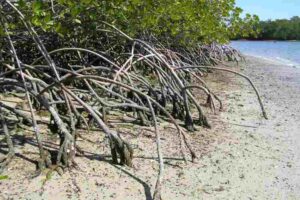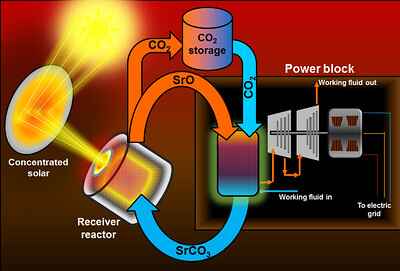9 Abiotic Factors in The Everglades and Their Functions
Abiotic factors in the Everglades are; sunlight, water, physicochemical parameters, soil, parent rock materials, nutrients, dissolved oxygen, suspended solids, floods and tidal surges.
This article discusses abiotic factors in the Everglades, and their functions, as follows;
1). Sunlight (as one of the Abiotic Factors in the Everglades)
Sunlight is an important abiotic component of the Everglades ecosystem, and plays a pivotal role in influencing the interactions between various abiotic and biotic factors within this unique wetland environment.
The abundant sunlight in the Everglades is more than just a source of illumination; but also serves as a driving force that influences multiple ecological processes and sustains the composition and balance of this intricate ecosystem.
Functions of Sunlight in the Everglades
Sunlight in the Everglades; functions as an energy source, a facilitator of temperature regulation, species diversity and distribution, biotic interactions, nutrient cycling, respiration and oxygen production.
Solar radiation (which includes visible light) is the primary energy source for photosynthesis; the process by which autotrophs convert carbon dioxide and water into organic biomass, releasing oxygen as a byproduct [12].
The lush vegetation of the Everglades, including cattails and sawgrass, thrives on this energy to produce their own food.

Hot and humid conditions occur in the Everglades, especially during the summer season [10]. Sunlight directly influences temperature by warming the water and sediments. This thermal energy affects the water cycle, evaporation rates, and overall ecosystem dynamics.
Sunlight availability and intensity, both influence the distribution of plant species within the Everglades. Different plant species have varying light tolerances and requirements, and the coexistence of these species leads to distinct plant communities across the landscape.
By driving photosynthesis, sunlight also contributes to the diversity of hydrophytic vegetation, and supports habitats for various aquatic organisms.
Biotic and abiotic interactions are facilitated by sunlight in the Everglades. Aquatic vascular plants and algae, which thrive in the well-lit shallow waters of the Everglades, provide food materials and suitable habitats for a diverse range of organisms.
These plants create submerged structures that offer refuge from predators, and usable breeding sites.
Another way in which sunlight plays a role in the Everglades, and supports the food chain, is through nutrient cycling.
Sunlight drives the process of photosynthesis, which, in turn, fosters the cycling of nutrients in the ecosystem. As plants photosynthesize, they take up essential nutrients from the water and soil, incorporating them into their tissues. These nutrients are passed on through the food web as other organisms consume the plants; or as plant remains undergo biodegradation.
Photosynthesis not only generates energy-rich compounds, but also releases oxygen into the atmosphere. This oxygen production is vital for sustaining aerobic organisms, including aquatic life forms like fish.
Interplay Between Abiotic and Biotic Factors In The Everglades
The presence of sunlight creates a chain of trophic interactions between abiotic and biotic components within the Everglades ecosystem.
Sunlight determines the distribution and abundance of plants, which, in turn, affects the availability of food and habitats for herbivores and other organisms.
The energy derived from photosynthesis fuels the food web, by supporting herbivores, carnivores, and decomposers. Through photosynthesis, sunlight also influences the oxygen cycle, along with other nutrients which further connect the various elements of the ecosystem, and foster a delicate balance.
2). Water
Water is a fundamental abiotic factor in the Everglades ecosystem.
This is because of its contributions to shaping the unique characteristics and functions of this expansive wetland terrain.
The Everglades is often referred to as the "River of Grass," and is defined by its intricate network of water flow, which influences various ecological processes and supports a diverse range of flora and fauna [2].
Functions of Water in the Everglades
Functions of water in the Everglades include hydrological connectivity, habitat creation, nutrient transport, temperature regulation, and biodiversity enhancement.
Water serves as a connecting medium that weaves together the various habitats within the Everglades.
The wetland ecosystem is characterized by a slow and shallow flow-trend of water [8], which creates a mosaic of marshes, sloughs, and swamps that provide habitats for numerous species.

The distribution and abundance of aquatic and terrestrial organisms in the Everglades, are directly influenced by the presence of water. Different flow rates and water depths give rise to distinct habitats, such as sawgrass marshes, mangrove forests and cypress swamps, each of which caters to specific plant and animal species.
Water serves as a vehicle for transporting essential nutrients throughout the ecosystem. As it flows through various microhabitats, it picks up and carries nutrients from sediments, decomposed organic matter, and other sources, subsequently distributing these nutrients to different parts of the Everglades.
Temperature in the Everglades is moderated by water, which helps to maintain relatively stable conditions. The thermal inertia of water helps to prevent extreme temperature fluctuations, and provides a more suitable environment for both aquatic and terrestrial organisms.
Dynamic water flow and diverse habitats in the Everglades, contribute to the region's (relatively) high biodiversity. The availability of water supports a wide range of plant species, which, in turn, supports various animal species at different trophic levels.
Multiple species of fish, birds, and other wildlife rely on water bodies in the Everglades for breeding, nesting, and feeding. The slow flow-rate of water in the wetlands provides a suitable environment for these activities.
Overview of Water In The Everglades
The Everglades is predominantly a freshwater ecosystem, because it receives freshwater input from rivers and streams that flow through the wetland, to create an array of habitats.
The most important abiotic factor in the Everglades is water; because it is an ambient medium whose availability and movement, shape the ecosystem's structure, functions, and distribution of organisms.
Unique factors of the Everglades generally include slow water flow, multiple habitats, estuarine interactions, variable topography/geomorphology, and distinctive organic life.
The Everglades is characterized by its slow-moving water flow, which helps to establish and connect an array of habitats.
Interactions between freshwater and saltwater at the estuarine boundaries also contribute to the formation of diverse ecosystems.
The small changes in land elevation throughout the Everglades result in distinct habitats such as sawgrass marshes, cypress swamps, hardwood hammocks, mangrove swamps, and pinelands.
3). Physicochemical Parameters (as one of the Abiotic Factors in the Everglades)
Physicochemical parameters, including factors such as temperature, pH, dissolved oxygen, salinity, and nutrient concentrations, are all crucial to the conditions of the Everglades ecosystem.
These abiotic components interact with each other and with the biotic elements of the ecosystem, influencing the distribution, behavior, and interactions of various organisms.
Functions of Physicochemical Parameters
Functions of physicochemical parameters in the Everglades range from influencing metabolism to controlling nutrient dynamics, salinity, and organic distribution. These functions are discussed here in terms of the individual parameters responsible for them.
Temperature affects growth, reproduction, and overall metabolism of organisms [7]. It also influences the solubility of gases like oxygen, and impacts aquatic species' behavior and survival.
pH levels influence chemical reactions and nutrient availability in water. Organisms, especially aquatic species, have specific ranges of pH tolerance, beyond which their physiological functions can be affected.
Availability of oxygen in water, is crucial for aerobic organisms. Dissolved oxygen (DO) affects respiration, behavior, and habitat selection of aquatic species. Low DO levels can result in hypoxic conditions, impacting fish and aquatic invertebrates.
Salinity is a determinant factor in estuarine sections of the Everglades, where freshwater meets with saltwater. Organisms have varying levels of salinity tolerance, so that spatial variations in salinity may influence their distribution and community structure.
Nutrients such as nitrogen and phosphorus, have significant influence over primary production and eutrophication [3]. Excessive nutrient concentrations can result in harmful algal blooms that affect the entire food web.
Effects of Physicochemical Parameters On Organisms and Species Interactions In The Everglades
Physicochemical parameters determine the suitability of habitats for different species. For example, salinity levels influence the coexistence of freshwater and saltwater species at estuarine boundaries.
Organisms often select aquatic habitats based on their physicochemical preferences. Fish species, for example, may inhabit areas with specific temperature and dissolved oxygen conditions.
Temperature and DO levels both influence the activity and feeding patterns of fish. Diurnal changes in these parameters can affect the timing of feeding and locomotion.
Physicochemical variations can contribute to resource partitioning and competition avoidance among species. Different species may utilize distinct niches within the ecosystem due to suitable physicochemical conditions, enabling them to avoid direct competition.
Predator-prey dynamics are influenced by temperature, which controls metabolic rates of predators and prey. Predation rates and efficiency can be influenced significantly by the temperature-dependent activity levels of both predator and prey.
Changes in physicochemical parameters can lead to shifts in species composition over time. Eutrophication, for example, can alter primary production and affect the entire trophic structure of the Everglades.
4). Soil
Soil is an important abiotic component of the Everglades ecosystem, and serves as the foundation for various ecological processes and interactions.
It has a fundamental role to play in supporting plant growth, nutrient cycling, water filtration, and in providing habitat for a diverse array of organisms.
Functions of Soil in the Everglades Ecosystem
Functions of soil in the Everglades ecosystem include; plant growth and support, nutrient cycling, water conservation and filtration, habitat creation, carbon sequestration, and microclimatic influence.
Plants are supported by soil, which provides the necessary medium for their roots to anchor and access water and nutrients. The diverse plant species that occur in the Everglades, depend on different soil types for their growth and survival; so that soil can be said to shape the species composition of the resident plant community [11].

Soil acts as a reservoir for nutrients that are essential for plant and microbial growth. Nutrients from organic matter and detritus are released through biodegradation, by decomposers, and become available for uptake by plants.
Water retention is another function of soil in the Everglades, which has a key role in regulating water availability. It retains rainwater, thereby reducing surface runoff and helping to prevent flooding. The porous structure of the soil also filters pollutants, and improves water quality.
Everglades soil provides habitats for several microorganisms, insects, worms, and some burrowing mammals. These organisms contribute to nutrient recycling and play other important roles in the ecosystem.
A diverse community of microorganisms that carry out nutrient cycling, decomposition, and symbiotic relationships with plant roots, are hosted by the soil. These organisms influence nutrient availability and plant health.
Soil serves as a natural repository for organic carbon. Carbon sequestration in the soil contributes to climate regulation, by reducing the amount of carbon dioxide in the atmosphere.
Vegetation that is anchored in the soil helps to prevent erosion, and maintains the stability of the ecosystem. In the Everglades, where water flow is significant, preventing soil erosion is crucial for the continuity of wetland habitats.
Soil properties and composition, can impact local microclimates by affecting temperature and humidity levels. Microclimatic variations have an influence on plant and animal distribution.
Abiotic Factors in Soil Ecosystem
Three key abiotic factors in the soil ecosystem are; mineral composition, soil pH, and textural properties.
The types and proportions of minerals present in the soil impact its physical and chemical properties, as well as nutrient availability and water retention.
Soil pH influences the trends of nutrient solubility and microbial activity [6]. Different plant species thrive in soils with varying pH ranges, based on their adaptation and tolerance.
Texture of soil (proportions of sand, silt, and clay) as well as its structure, both influence water-holding capacity, aeration and drainage.
5). Parent Rock Materials (as one of the Abiotic Factors in the Everglades)
The parent rock materials, particularly limestone, are influential abiotic factors in the Everglades ecosystem.
These geological formations serve as the basis for various abiotic processes that influence water flow, water chemistry, and ecosystem structure.
Functions of Parent Rock Materials in the Everglades Ecosystem
Parent rock materials contribute to water flow, hydrological configuration, karst topography, aquifer formation, water chemistry, buffering capacity, and groundwater dynamics.
Limestone is a dominant parent rock material in the Everglades, and often forms the foundation of the underlying geology in this ecosystem [9].
It is a highly porous rock, which allows water to percolate and flow through interconnected cavities. This porous structure influences the hydrology of the entire ecosystem.
The dissolution of limestone by slightly acidic rainwater over time, produces unique landforms collectively known as karst topography. Sinkholes, solution basins, and underground rivers are examples of karst features. These features affect water dynamics, creating areas of concentrated flow and groundwater recharge.

Limestone bedrock that underlies the Everglades, contributes to the formation of a vast underground aquifer. This aquifer serves as a critical source of freshwater for the region, and influences both surface water availability and the survival of wetland habitats.
As water interacts with limestone, it assimilates minerals like calcium and magnesium, which affect the chemical composition of the water. These dissolved minerals exert their influence upon the water's pH and nutrient content, thereby impacting aquatic vegetation and animal life.
Limestone substrates provide surfaces of attachment for epiphytic plants, algae, and other anchor-dependent organisms. These attached organisms contribute to the overall biodiversity and may provide microhabitat for various species.
The ability of limestone to neutralize acids contributes to the buffering capacity of water bodies in the Everglades. This buffering helps in maintaining stable pH levels, which is important for aquatic life.
Karst features like springs and ponds can be found within the Everglades. These unique habitats provide specialized niches for aquatic organisms, and contribute to the overall diversity of the ecosystem.
Limestone acts as a conduit for groundwater flow, and leads to the discharge of freshwater into surface water bodies. This discharge helps regulate salinity and contributes to the overall water balance of the ecosystem.
6). Nutrients
Nutrients are essential abiotic components in the Everglades ecosystem, that are involved in driving primary productivity, supporting food webs, and influencing the entire ecological structure and function of the wetland environment.
Functions of Nutrients in the Everglades Ecosystem
Functions of nutrients in the Everglades ecosystem range from primary productivity to food web sustenance, aquatic plant growth, nutrient cycling, aquifer recharge, water quality maintenance, eutrophication effects, biodiversity conservation, and contribution to human-induced environmental impacts.
Nutrients like phosphorus and nitrogen, are fundamental for plant growth and primary production [4]. These nutrients are absorbed by aquatic macrophytes and other plants, which occupy the foundation of the Everglades food web.
The availability of nutrients influences the growth of primary producers in the Everglades, which in turn provide food for herbivores, omnivores, and carnivores. Nutrient-rich environments are able to support a diverse range of species interactions and trophic relationships.
Nutrient-rich waters are instrumental toward the growth of aquatic plants, and contribute to the development of dense vegetative masses in the Everglades marshes. These plants create habitats, provide shelter for various organisms, and contribute to nutrient cycling.
Nutrients are cycled through the ecosystem as organic matter is decomposed by microorganisms. Decomposition releases these nutrients back into the water column and sedimentary substrate, thereby making them available for uptake and reuse, by plants.
The absorption and retention of excess nutrients by the Everglades, help prevent nutrient pollution in the downstream zone. Nutrient removal from water entering the Everglades (and percolating into underground aquifers) can contribute to the maintenance of groundwater quality in this region.
Nutrient levels in the Everglades influence water quality parameters like nutrient concentrations, turbidity, and algal growth. Balanced nutrient levels are important for maintaining a healthy aquatic environment.
While nutrients are necessary for growth, excessive nutrient enrichment can lead to eutrophication, causing algal blooms, depleting oxygen reserves, and disrupting the ecosystem structure.
Nutrient availability affects species composition, diversity, adaptation and biological success, within the Everglades. Different plant species have varying nutrient requirements, so that spatial variations in nutrient distribution contribute to the diverse mosaic of habitats in the wetland.
Human activities and their outcomes, such as urban development and agricultural runoff, can introduce excess nutrients into the Everglades. These inputs tend to disrupt natural nutrient cycling and lead to ecological imbalances with different levels of severity.
7). Dissolved Oxygen (as one of the Abiotic Factors in the Everglades)
Dissolved oxygen (DO) is another critical abiotic component of the Everglades ecosystem, which is often listed among its physicochemical parameter.
It has profound effects on aquatic organisms, nutrient cycling, and overall ecosystem health; influencing the distribution, behavior, and survival of various species within this environment.
Functions of Dissolved Oxygen in the Everglades Ecosystem
The functions of dissolved oxygen in the Everglades ecosystem include; respiration, organic survival, aquatic food web sustenance, decomposition, nutrient cycling, ecosystem health indication, ecologic resilience building, and influence on species distribution.
Aquatic organisms, from autotrophic macrophytes to fish and invertebrates, generally rely on dissolved oxygen for their respiration. Adequate DO levels are essential for metabolic processes and overall survival of these organisms.
Availability of dissolved oxygen affects the composition and diversity of aquatic species. Different species have varying oxygen requirements, which influence the structure/nature of food webs and species interactions.

Decomposition of organic matter is mediated by aerobic microorganisms that rely on dissolved oxygen. Proper decomposition contributes to nutrient cycling, helps maintain water quality, and supports primary productivity.
Dissolved oxygen serves as an indicator of the overall health and balance of the aquatic ecosystem. Low DO levels can signal water quality degradation and potential ecological imbalances.
Oxygen solubility in water depends on factors such as temperature, salinity, and atmospheric pressure. High temperatures and low atmospheric pressure reduce oxygen solubility, and potentially lead to lower DO levels.
Adequate levels of dissolved oxygen enhance the resilience of aquatic organisms to various stressors, including changes in salinity, temperature, and pollutant concentration.
Dissolved oxygen gradients in the Everglades, influence the distribution of species especially along the freshwater-to-saltwater gradient. Some species are adapted to thrive in low-oxygen environments, while others require higher DO concentrations.
Maintaining sufficient DO levels prevents hypoxia (low oxygen) conditions, which can result in fish kills, and may have negative impacts on the health of the aquatic ecosystem.
Factors Influencing Dissolved Oxygen Levels
Factors influencing dissolved oxygen levels include; temperature, salinity, and atmospheric pressure.
With regards to temperature, warmer water holds less dissolved oxygen than cooler water. Increasing temperatures decrease oxygen solubility, and affect the respiratory rates of aquatic organisms.
Freshwater has a generally higher oxygen concentration than saltwater. Mixing of freshwater and saltwater in the Everglades influences DO levels.
Lower atmospheric pressure reduces the solubility of oxygen in water. This implies that changes in weather patterns can influence DO concentrations.
Clarifying The Status of Dissolved Oxygen as An Abiotic Factor
Dissolved oxygen is considered an abiotic factor in ecosystems, because if is a non-living and inorganic component/parameter that influences both the environment and organisms within it.
It affects the physical and chemical properties of the aquatic environment, and has a direct determinant effect on aquatic organisms' survival and behavior.
8). Suspended Solids
Suspended solids are often referred to as particulate matter, and can be classified as an abiotic component in the Everglades ecosystem.
These particles that remain suspended in the water column have important functions, and effects on water quality, nutrient cycling, and other ecological dynamics.
Functions of Suspended Solids in the Everglades Ecosystem
The functions of suspended solids in the Everglades ecosystem include; nutrient transport, light attenuation, habitat diversification, contaminant dynamics, deposition and sedimentation, degradation, influence on filter-feeders and water quality.
Suspended solids can act as carriers of nutrients such as phosphorus, carbon and nitrogen.
These particles are either composed of, or bound to nutrients, so that they influence their transport and distribution within the ecosystem. The movement of nutrients through suspended solids can affect primary production and plant growth in the Everglades.
Interactions between suspended solids and light can involve scattering and absorption, which lead to reduced light penetration in the water column [2]. This can have implications for photosynthesis and growth of aquatic plants, particularly in shallow areas where light availability is a crucial metric.
The presence of suspended solids can contribute to the formation of different microhabitats within the water column. Some aquatic organisms, like certain fish species, may utilize these particles for refuge and protection from predators; while other organisms may navigate to less-saturated areas.
Pollutants and contaminants can adsorb onto suspended particles. These particles can then act as carriers, and may potentially impact both aquatic organisms and water quality.
Most suspended solids eventually settle to the bottom, where they contribute to sedimentation. This can influence sediment composition, depth, and substrate characteristics, and can shape the attributes of benthic habitats.
Increased concentration of suspended solids can serve as an indicator of erosion and land disturbance within the watershed. These particles may carry sediment, nutrients, and pollutants from surrounding areas into the Everglades.
Filter-feeding organisms, including some bivalves and aquatic insects, rely on suspended particles as a food source. These organisms can help in filtering the water and affecting nutrient dynamics; through their activities.
High concentrations of suspended solids can also decrease water clarity, impairing visibility and the altering aesthetics of the water body.
Effects of Suspended Solids on Organisms and Ecosystem Interactions In The Everglades
The effects of suspended solids on the Everglades ecosystem have been highlighted in the preceding section. Some of them are reiterated here.
Suspended solids can influence species interactions by affecting predator-prey relationships and habitat conditions.
Photosynthetic organisms are susceptible to the impacts of reduced light availability caused by the presence of suspended solids.
Filter-feeding organisms that rely on suspended particles for food may also be affected by changes in particle concentrations.
Clarification Of The Status of Suspended Solids As Abiotic Factors
Suspended solids are considered abiotic components in ecosystems, as they are non-living materials that exert influence on the physicochemical environment and its organic inhabitants.
In the Everglades, suspended solids occur as particulates present in the water column that affect water quality and ecological processes.
9). Floods and Tidal Surges (as Abiotic Factors in the Everglades)
Floods and tidal surges are significant abiotic components/phenomena that occur in the Florida Everglades ecosystem.
These hydrological events are driven by factors such as heavy rainfall, tidal influence, and storm surges, and make effective contributions to the Everglades' structure, nutrient cycling processes, and species composition, among others.
Functions of Floods and Tidal Surges in the Everglades Ecosystem
The functions of floods and tidal surges in the Everglades may be hazardous or constructive; and include; nutrient redistribution, habitat creation, species movement/distribution, seed dispersal, aquatic connectivity, water quality improvement, and sediment deposition.
Nutrient redistribution by floods and tidal surges, occurs along with the hydrological dynamics of sediments, and organic matter within the ecosystem. Nutrients carried by stormwater can enrich soil and enhance productivity in areas where they are 'deposited.'
Creation and renewal of wetland habitats are functions of floods and tidal surges. These events can alter water depths and create temporary habitats that support a diverse range of aquatic and semi-aquatic species.

The distribution and movement of aquatic organisms in the Everglades, can also be influenced by floods and tidal surges.
Some species rely on these events to access different microhabitats for breeding, feeding, and refuge.
Seed dispersal is yet another phenomenon that can be attributed to hydrological events in the Everglades. Floodwaters can transport plant seeds across the landscape, promoting seed dispersal and facilitating the spatial dominance of plant species.
Floods and tidal surges are key to maintaining connectivity between different wetland areas, allowing for gene flow and species movement.
Tidal surges can influence water mixing and improve water quality, by flushing out stagnant or nutrient-rich waters; and diluting polluted water masses.
Sediments are deposited in different areas by floods and tidal surges, thereby influencing sediment composition, substrate characteristics, and nutrient availability.
Effects Of Flooding And Tidal Surges On Organisms and Ecosystem Interactions
Flooding can affect nesting and breeding success of certain bird species by altering water levels and food availability.
Tidal surges influence salinity gradients, affecting the distribution of aquatic species that are adapted to different salinity levels.
Floods can cause temporary shifts in predator-prey dynamics, creating opportunities for some species while challenging others.
Susceptibility of The Everglades to Flooding
The feature of the Florida Everglades that makes it highly susceptible to flooding, is low land elevation (and low topographic gradient [5]). The Everglades is a generally flat and low-lying landscape, with land elevations close to or slightly above sea level.
This characteristic, combined with its shallow water table and complex/dense hydrological patterns, makes the ecosystem vulnerable to inundation during periods of heavy rainfall, storm surges, and tidal fluctuations.
Conclusion
Abiotic factors in the Everglades are;
1. Sunlight
2. Water
3. Physicochemical Parameters
4. Soil
5. Parent Rock Materials
6. Nutrients
7. Dissolved Oxygen
8. Suspended Solids
9. Floods and Tidal Surges
References
1). Brown, R. (1984). "RELATIONSHIPS BETWEEN SUSPENDED SOLIDS, TURBIDITY, LIGHT ATTENUATION, AND ALGAL PRODUCTIVITY." Lake and Reservoir Management, Volume 1, 1984 - Issue 1. Available at: https://doi.org/10.1080/07438148409354510. (Accessed 24 August 2023).
2). Brown, M.; Cohen, M.; Bardi, E.; Ingwersen, W. W. (2006). "Species diversity in the Florida Everglades, USA: A systems approach to calculating biodiversity." Aquatic Sciences 68(3):254-277. Available at: https://doi.org/10.1007/s00027-006-0854-1. (Accessed 24 August 2023).
3). Dodds, W. K.; Smith, V. H. (2016). "Nitrogen, phosphorus, and eutrophication in streams." Available at: https://doi.org/10.5268/IW-6.2.909. (Accessed 24 August 2023).
4). Guignard, M. S.; Leitch, A. R.; Acquisti, C.; Eizaguirre, C.; Elser, J. J.; Hessen, D. O.; Jeyasingh, P.; Neiman, M.; Richardson, A. E.; Soltis, P. S.; Soltis, D. E.; Stevens, C. J.; Trimmer, M.; Weider, L.; Woodward, G.; Leitch, I. (2017). "Impacts of Nitrogen and Phosphorus: From Genomes to Natural Ecosystems and Agriculture." Frontiers in Ecology and Evolution 5(5):70. Available at: https://doi.org/10.3389/fevo.2017.00070. (Accessed 24 August 2023).
5). Gunderson, L. H.; Loftus, W. F. (1999). "Everglades." Available at: https://www.researchgate.net/publication/296355149_Everglades. (Accessed 24 August 2023).
6). Husnain, A.; Hussain, I.; Ijaz, A. B.; Zafar, A.; Imran, Ch. B.; Zafar, H.; Sohail, M. D.; Niazi, H.; Touseef, M.; Khan, A. A.; Tariq, M.; Yousaf, H.; Usama; M. (2021). "Influence of Soil Ph and Microbes on Mineral Solubility and Plant Nutrition: A Review Author's Details." Available at: https://www.academia.edu/45623685/Influence_of_Soil_Ph_and_Microbes_on_Mineral_Solubility_and_Plant_Nutrition_A_Review_Authors_Details. (Accessed 24 August 2023).
7). Islam, A.; Uddin, H.; Uddin, J.; Shahiahan, (2019). "Temperature changes influenced the growth performance and physiological functions of Thai pangas Pangasianodon hypophthalmus." Aquaculture Reports. Available at: https://doi.org/10.1016/j.aqrep.2019.100179. (Accessed 24 August 2023).
8). Leonard, L. A.; Croft, A.; Childers, D.; Mitchell-Bruker, S.; Solo-Gabriele, H. M.; Ross, M. (2006). "Characteristics of surface-water flows in the ridge and slough landscape of Everglades National Park: Implications for particulate transport." Hydrobiologia 569(1):5-22. Available at: https://doi.org/10.1007/s10750-006-0119-y. (Accessed 24 August 2023).
9). Mcneill, D. F.; Pederson, C.; Brownlow, D.; Klaus, J. S.; Blackwelder, P. L. (2019). "Quantifying carbonate sediment mixing across a formational boundary, an example from the Late Pleistocene Miami Limestone." Wiley, The Depositional Record 5(3). Available at: https://doi.org/10.1002/dep2.87. (Accessed 24 August 2023).
10). Richardson, C. (2010). "The Everglades: North America’s subtropical wetland." Wetlands Ecology and Management 18(5):517-542. Available at: https://doi.org/10.1007/s11273-009-9156-4. (Accessed 24 August 2023).
11). Wang, O.; Li, Y.; Zhang, M. (2015). "Soil recovery across a chronosequence of restored wetlands in the Florida Everglades." Springer Nature, Scientific Reports 5(1):17630. Available at: https://doi.org/10.1038/srep17630. (Accessed 24 August 2023).
12). Zhu, X.; Long, S. P.; Ort, D. R. (2008). "What is the Maximum Efficiency With Which Photosynthesis can Convert Solar Energy into Biomass?" Current Opinion in Biotechnology 19(2):153-9. Available at: https://doi.org/10.1016/j.copbio.2008.02.004. (Accessed 24 August 2023).



